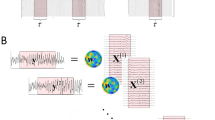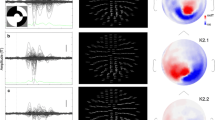Summary
Spatial principal components analysis (SPCA) applied to the ongoing EEG yields factor loadings which, when mapped, consistently reveal symmetrical patterns resembling the spherical harmonics. In this paper, we consider the mechanisms responsible for these characteristic patterns. In doing so, we demonstrate that volume conduction is one of a family of processes capable of generating such patterns with SPCA. It is shown that any series of measurements on a sphere in which the covariance is only a function of measurement site angular separation (shift invariant processes) will yield the spherical harmonics as the eigenvectors or factor loadings of the covariance matrix. Simulations further indicate that this effect is robust and not determined by the geometry of the measurement sites. In situations where shift invariant signals coexist with those generated at specific sites (anatomically specific processes), such as evoked potentials and some artifacts, it is shown that the anatomically specific signals do not influence the eigenvectors of the covariance matrix in a uniform or random fashion. The factors most influenced are those whose symmetry is similar to that of the site specific signal.
Similar content being viewed by others
References
Duffy, F. H., Jones, K., Bartels, P., Albert, M., McAnulty, G. B. and Als, H. Quantified Neurophysiology with mapping: Statistical inference, exploratory and confirmatory data analysis. Brain Topography, 1990, 3: 3–12.
Glaser, E. M. and Ruchkin, D. S. Principles of neurobiological signal analysis. Academic Press. New York, 1976.
Gourlay, A. R. and Watson, G. A. Computational Methods for Matrix Eigenproblems. John Wiley & Sons. New York, 1973.
Hannan, E. J. Multiple time series. John Wiley & Sons. New York, 1970.
Hobson, E. W. The theory of spherical and ellipsoidal harmonics. Chelsea publishing Company. New York, 1931.
Jolliffe, I. T. Principal Component Analysis. Springer-Verlag, New York, 1986.
Kavanagh, R. N., Darcey, T. M. and Fender, D. H. The dimensionality of the human visual evoked potential. Electroenceph. clin Neurophysiol., 1976, 40: 633–644.
Maier, J., Dagnelie, G., Spekreijse, H. and Van Dijk, B. W. Principal components analysis for source localization of VEPs in man. Vision Res., 1987, 27: 165–177.
Nunez, P. L. Electric fields of the brain: The neurophysics of EEG. Oxford University Press, New York, 1981.
Nunez, P. L. Removal of reference electrode and volume conduction effects by spatial deconvolution of evoked potentials using a three concentric sphere model of the head. EEG Suppl., 1987, 39: 143–148.
Schier, M. A., Ciorciari, J., Silberstein, R. B. and Simpson D. G. Requirements of a high spatial resolution brain electrical activity data acquisition system. Neuroscience Letters., 1988, Suppl 30, S151.
Silberstein, R. B., Cadusch, P. J. and Schier, M. A. Volume conduction effects on spatial principal components analysis of scalp recorded brain electrical activity. Brain Topography, 1990, 3: 273–274.
Skrandies, W. and Lehmann, D. Spatial principal components of multichannel maps evoked by lateral visual half-field stimuli. Electroenceph clin Neurophysiol., 1982, 54: 662–667.
Author information
Authors and Affiliations
Additional information
Acknowledgements: The authors are happy to acknowledge the technical assistance of Andrew Pipingas, Geoff Nield, Guy Burkitt and Glen Thomas. The authors also acknowledge the suggestions made by Joseph Ciorciari and Mark Schier on an earlier draft of this paper.
Rights and permissions
About this article
Cite this article
Silberstein, R.B., Cadusch, P.J. Measurement processes and spatial principal components analysis. Brain Topogr 4, 267–276 (1992). https://doi.org/10.1007/BF01135564
Accepted:
Issue Date:
DOI: https://doi.org/10.1007/BF01135564




